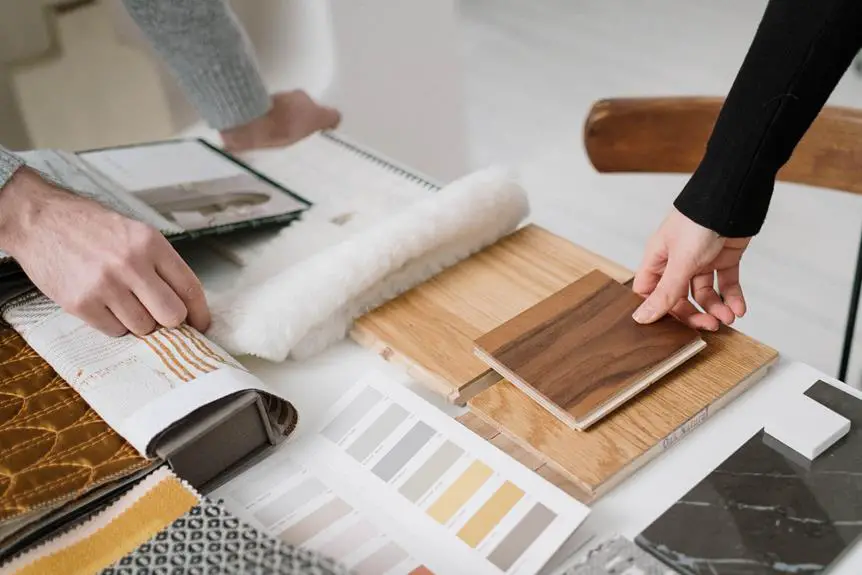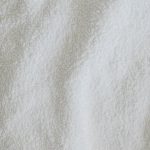Hey there, ready to master the art of hand stitching?
When it comes to working with different fabrics, knowing which stitches to use can make all the difference. Whether you're dealing with delicate silk, heavy denim, or stretchy knits, there's a perfect stitch for every fabric.
Understanding the right techniques will elevate your sewing game and give your projects a professional finish. From basic stitches that work for all fabrics to intricate decorative stitches for embellishments, we've got you covered.
So, grab your needle and thread, because we're about to dive into the world of hand stitches and take your sewing skills to the next level.
Key Takeaways
- The running stitch is a fundamental hand-sewing technique that serves as the foundation for other stitches.
- Choosing the right needle for the fabric's weight is important for achieving optimal results.
- Adjusting thread tension is crucial for creating consistent and professional-looking finishes.
- Practice and patience are key to honing your hand-sewing skills.
Basic Hand Stitches for All Fabrics
When stitching fabrics by hand, you should begin with mastering the basic running stitch. This fundamental stitch is versatile and forms the foundation for more intricate hand-sewing techniques.
To start, choose the right needle for the fabric you're working with. For lighter fabrics like silk or cotton, a finer needle will prevent damage, while heavier fabrics like denim or upholstery may require a sturdier needle to penetrate the fibers effectively.
When it comes to thread tension, remember that it should be taut enough to hold the fabric together without causing puckering or distortion. Adjust the tension as needed throughout your stitching to ensure a consistent and professional finish.
As you delve into the world of hand-stitching, mastering the basics sets you on the path to creating beautiful, durable seams. Understanding needle selection and thread tension are crucial components of this mastery.
With the running stitch at your fingertips, and armed with the knowledge of needle and thread, you're ready to embark on your hand-sewing journey. Remember, practice and patience are key to honing your skills.
Best Stitches for Delicate Fabrics
Selecting the appropriate stitch for delicate fabrics involves considering their weight and weave, ensuring a gentle and secure hold. When working with delicate fabrics such as silk or sheer materials, it's crucial to employ techniques that minimize the risk of damage.
For silk stitches, using fine thread methods is essential. The lightweight and smooth texture of silk necessitates a delicate touch, making small, nearly invisible stitches the best choice.
When stitching sheer fabrics, it's important to opt for fine thread methods that won't weigh down the material or cause it to pucker. Using a sharp, thin needle and lightweight thread will help maintain the fabric's delicate nature while providing the necessary reinforcement.
To achieve the best results with delicate fabrics, it's imperative to practice patience and precision. Take the time to select the appropriate needle and thread, and always test your stitches on a small piece of fabric before working on the actual garment or project.
Ideal Stitches for Heavy Fabrics
When working with heavy fabrics, such as denim or wool, it's important to choose stitches that provide both strength and durability. Heavy fabrics require special attention when it comes to stitching, as they can be more challenging to work with compared to lighter materials.
One of the key tips for stitching heavy fabrics is to use a thicker and stronger thread. This will provide the necessary durability to withstand the weight and tension that heavy fabrics often demand.
In addition to using a thicker thread, employing techniques like backstitching can significantly enhance the strength of the seam. Backstitching involves overlapping the stitches, creating a secure and durable hold that prevents the fabric from unraveling.
Another beneficial technique for heavy fabrics is using a thimble to push the needle through the material. Heavy fabrics can be tough to penetrate, and a thimble provides the extra force needed to sew through them effectively.
Stitching Techniques for Stretchy Fabrics
When working with stretchy fabrics, it's important to choose the right stitching techniques to ensure that the fabric retains its stretch and doesn't pucker or break.
In this section, we'll explore the best stitches for stretchy fabrics and how to handle them effectively.
Understanding these techniques will help you achieve professional-looking results with your stretchy fabric projects.
Best Stitches for Stretchy
Using a zigzag stitch is ideal for sewing stretchy fabrics because it allows for flexibility and prevents the thread from breaking.
When working with stretchy fabrics, such as spandex or jersey, you need stitching techniques that can move with the fabric without causing it to pucker or break. A zigzag stitch is perfect for this because it stretches with the fabric, preventing the stitches from popping when the fabric is stretched. It also provides a strong hold, keeping the seams secure even with the fabric's movement.
Additionally, using a ballpoint needle and walking foot can further enhance your stretchy fabric stitches handling techniques. These tools and techniques will help you achieve professional-looking results while working with stretchy fabrics, ensuring your garments or projects maintain their flexibility and comfort.
Handling Stretchy Fabric Stitches
For stitching stretchy fabrics, you should use a zigzag stitch to allow for flexibility and prevent thread breakage. When working with stretchy fabrics like spandex or jersey, the usual straight stitch may cause the threads to break when the fabric stretches.
A zigzag stitch, on the other hand, provides more give and reduces the likelihood of popped threads. When selecting needles for stitching stretchy fabrics, opt for a ballpoint or stretch needle. These needles have a slightly rounded tip, which allows them to slip through the fibers of the fabric without causing damage.
Additionally, adjusting the thread tension can make a significant difference. Loosening the tension slightly can help prevent the fabric from puckering or stretching out of shape, resulting in a more professional finish.
Decorative Stitches for Embellishments
Are you ready to take your hand stitching to the next level with decorative stitches for embellishments?
Let's explore different stitch types that work best for adding embellishments to your fabric.
We'll also discuss which fabrics are most suitable for these decorative stitches and share some tips for achieving precision in your sewing.
Stitch Types for Embellishments
How can you create decorative stitches for embellishments using hand sewing techniques?
When it comes to adding unique embellishments to your fabric, there are several hand stitches that can elevate the overall look of your project.
Here are some stitch types for embellishments:
- French Knots: These small, textured knots are perfect for adding dimension and interest to your fabric.
- Seed Stitch: By evenly spacing small, straight stitches, you can create a textured, speckled effect that works wonderfully for floral designs or filling in shapes.
- Chain Stitch: This versatile stitch can be used to create beautiful borders, outlines, and even intricate designs.
Experimenting with these stitch types can elevate your creative embroidery and add a unique touch to your fabric projects.
Fabric Suitability for Stitches
To determine the most suitable fabric for your decorative stitches when embellishing, consider the texture and weight of the fabric as they will impact the overall look and durability of your hand-stitched embellishments. Different fabrics can handle various decorative stitches differently. Here's a guide to help you select the right fabric for your needle and thread art:
| Fabric Type | Suitable Stitches | Unsuitable Stitches |
|---|---|---|
| Cotton | Running Stitch, French Knots | Blanket Stitch, Bullion Knots |
| Silk | Satin Stitch, Chain Stitch | Back Stitch, Cross Stitch |
| Denim | Whip Stitch, Cross Stitch | Feather Stitch, Lazy Daisy |
Tips for Precision Sewing
For precision sewing of decorative stitches for embellishments, ensure your needle's eye is large enough for the thread. When working on embellishments, choosing the right needle is crucial. Additionally, pay attention to the thread tension to prevent puckering or loose stitches. Selecting the appropriate needle and adjusting the thread tension will significantly impact the quality of your decorative stitches.
- Needle Selection: Choose a needle with a large enough eye for the thread to pass through easily.
- Thread Tension: Adjust the tension to ensure the thread flows smoothly without causing puckering or loose stitches.
- Stitch Length and Hand Positioning: Experiment with different stitch lengths and maintain steady hand positioning for precise and consistent decorative stitches.
Mastering these tips will elevate the quality of your decorative stitching for embellishments.
Finishing Stitches for Professional Results
For professional results, finish your hand-stitched fabric projects with careful attention to detail and precision. To achieve a tailored finish, it's essential to master the art of finishing stitches. Here are some essential finishing stitches and their applications:
| Stitch Type | Best For | How-to |
|---|---|---|
| Slip Stitch | Closing seams invisibly on silk and satin | Fold the fabric edges, sew through the fold |
| Blind Hem Stitch | Creating nearly invisible hems | Catch a few threads from the garment and fold fabric |
| Overcast Stitch | Preventing fraying on lightweight fabrics | Sew over the fabric edge with closely spaced stitches |
| Whip Stitch | Hand-finishing raw edges | Pass the needle over the edge in a diagonal motion |
Mastering these finishing stitches is crucial for achieving professional results. They require precision sewing techniques and careful attention to detail. Whether you're working with delicate silk, creating a tailored finish on satin, or preventing fraying on lightweight fabrics, these stitches will elevate your hand-stitched fabric projects to the next level.
Frequently Asked Questions
How Can I Ensure My Hand Stitches Are Secure and Won't Come Undone?
To ensure your hand stitches are secure and won't come undone, focus on stitch security and knotting techniques. Choose the right needle, adjust thread tension, and master the art of knotting to keep your stitches in place.
Are There Any Special Techniques for Stitching on Leather or Suede?
When stitching on leather, use a glover's needle and strong waxed thread. For decorative stitching, try the saddle stitch for durability. When embroidering suede or stitching delicate fabrics, use a sharp needle and be gentle to avoid damaging the material.
Can I Use the Same Stitches for Both Natural and Synthetic Fabrics?
Yes, you can use the same stitching techniques for both natural and synthetic fabrics. However, it's important to consider fabric compatibility when choosing your stitches. Some fabrics may require specific stitches for optimal results.
What Types of Thread Are Best for Hand Stitching Different Fabrics?
For hand stitching different fabrics, consider using silk thread for delicate silk fabric, cotton thread for breathable denim, and polyester or nylon thread for synthetic fabrics. Each type of thread complements the unique properties of specific fabrics.
Are There Any Specific Hand Stitches That Work Well for Hemming and Finishing Edges on Different Types of Fabrics?
When hemming and finishing edges, it's essential to match hand stitch techniques with fabric compatibility. For delicate fabrics like silk, a tiny slip stitch works wonders, while a sturdy blanket stitch suits heavier fabrics like wool.
- Which Fabrics Are Hypoallergenic for Atopic Dermatitis? - June 5, 2025
- Hypoallergenic Clothing Fabrics for Contact Dermatitis Relief - June 5, 2025
- Best Hypoallergenic Fabrics for Eczema Flare-Up Prevention - June 5, 2025






